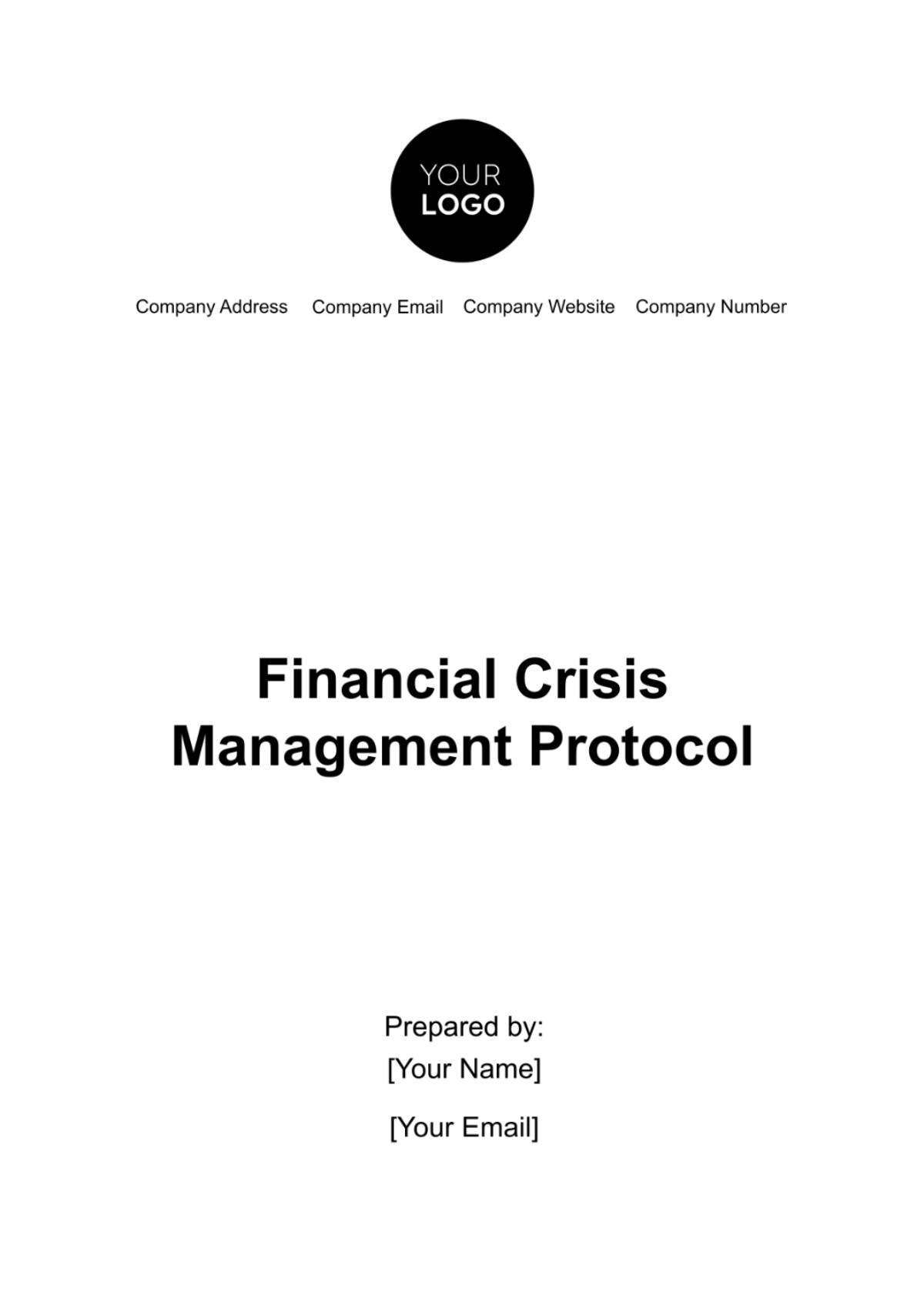Free Financial Crisis Management Protocol

1. Introduction
In an increasingly volatile economic landscape, the ability to swiftly and effectively respond to financial crises is paramount for the sustainability and growth of any business. Recognizing this critical need, [Your Company Name] has developed a comprehensive Financial Crisis Management Protocol. This protocol serves as a guiding framework to proactively identify, adeptly manage, and efficiently recover from financial crises that could potentially impact our operations and stakeholder interests.
The essence of this protocol lies in its structured approach, which is meticulously designed to address various stages of a financial crisis. Beginning with the early identification of potential financial risks and warning signs, the protocol encompasses detailed measures to swiftly assess the severity and potential impact of a crisis. By establishing clear criteria and thresholds for concern, such as cash flow fluctuations, revenue declines, market trends, and credit rating changes, we ensure that critical issues are recognized promptly and accurately.
Once a crisis is identified, our specialized Crisis Management Team, comprising key personnel from various departments, is mobilized to navigate through the complexities of the situation. This team, armed with strategic responsibilities and action plans, forms the cornerstone of our crisis response effort. Their diverse expertise, ranging from financial analysis to legal advice, enables a multi-faceted approach to crisis management, ensuring that all aspects of the crisis are addressed comprehensively.
Communication strategy forms another critical component of this protocol. Maintaining transparent and consistent communication with both internal and external stakeholders is crucial during a crisis. Our protocol outlines specific guidelines for internal communication to employees and external communication to customers, investors, and the public, ensuring that accurate information is disseminated effectively, thereby preserving trust and confidence in our organization.
Furthermore, the protocol details a variety of financial management strategies to be deployed during a crisis. These strategies are tailored to mitigate financial risks, safeguard assets, and maintain operational continuity. From cost reduction and asset liquidation to engaging with investors and negotiating credit lines, each strategy is thoughtfully designed to navigate the financial challenges posed by the crisis.
This Financial Crisis Management Protocol is not just a contingency plan; it is a testament to [Your Company Name]'s resilience and commitment to excellence. It underscores our dedication to safeguarding our enterprise against financial uncertainties and demonstrates our unwavering commitment to our stakeholders. Through this protocol, [Your Company Name] is well-equipped to face financial adversities with confidence and emerge stronger, with an unshaken focus on long-term stability and growth.
2. Crisis Identification and Assessment
The success of [Your Company Name] in navigating through financial turbulence hinges significantly on our ability to promptly identify and assess potential crises. The second chapter of our Financial Crisis Management Protocol, "Crisis Identification and Assessment," is dedicated to establishing a robust framework for detecting early warning signs and initiating immediate actions. This proactive approach is vital for mitigating risks before they escalate into a full-blown crisis.
Our protocol defines specific criteria and indicators that signal potential financial distress. These are categorized into four primary areas: Cash Flow, Revenue, Market Trends, and Credit Status. For each category, we have established clear indicators and corresponding actions, as well as defined thresholds that trigger immediate concern. This systematic approach allows for early detection and prompt response to adverse financial conditions.
Criteria | Indicator | Action Required | Threshold for Concern |
Cash Flow | Decrease in cash reserves | Review budget and expenditures | Below [$000.00] |
Revenue | Decline in sales/revenue | Enhance sales strategies | Drop by 20% from last quarter |
Market Trends | Negative market changes | Strategic meeting with management | Market decline > 15% |
Credit | Deterioration of credit rating | Consult financial advisors | Drop by 2 levels |
Procedure:
Immediate Reporting:
Upon identifying any indicator that reaches the set 'Threshold for Concern', it is imperative that this information is immediately reported to the Crisis Management Team. This ensures that potential issues are brought to the attention of decision-makers without delay.
This reporting should be done through established channels to ensure swift communication and response.
Assessment:
Following the reporting of a potential crisis indicator, the Crisis Management Team convenes to conduct a thorough assessment. This assessment is aimed at understanding the severity and potential impact of the identified issue on [Your Company Name].
The team utilizes a range of analytical tools and expertise to gauge the situation, considering both immediate and long-term implications. This comprehensive evaluation forms the basis for deciding on the appropriate course of action.
This chapter underscores the importance of vigilance and responsiveness in financial crisis management. By adhering to these procedures, [Your Company Name] positions itself to effectively manage and mitigate financial risks, safeguarding our stability and ensuring continued operational success.
3. Crisis Management Team
The third chapter of our Financial Crisis Management Protocol focuses on the formation and mobilization of the Crisis Management Team (CMT). This team is pivotal in the effective management of any financial crisis at [Your Company Name]. It is composed of key personnel who bring diverse expertise and decision-making capabilities essential for navigating through complex financial challenges. The effectiveness of our response to a financial crisis is significantly dependent on the prompt and coordinated actions of this team.
The CMT is structured to include roles that cover all critical aspects of crisis management, ranging from financial analysis to legal advice and communications. Each member is selected based on their expertise, experience, and ability to perform under pressure. The composition of the team is as follows:
Role | Name | Contact | Responsibility |
Team Leader | [Your Name] | [Your Personal Email] | Overall coordination and management of the crisis |
Financial Advisor | TBA | TBA | Providing financial analysis and advice |
Communications Lead | TBA | TBA | Handling all internal and external communications |
Legal Advisor | TBA | TBA | Offering legal guidance and ensuring compliance |
The activation of the Crisis Management Team is a critical step in our crisis response mechanism. The protocol for activation is as follows:
Team Assembly:
Upon identification of a potential crisis, the Team Leader is responsible for assembling the CMT immediately. This involves contacting all team members and briefing them on the situation at hand.
The assembly can be physical at [Your Company Address] or virtual, depending on the nature and urgency of the crisis.
Initial Meeting:
The CMT convenes for an initial meeting within 24 hours of activation. This meeting is crucial for understanding the scope of the crisis and planning the initial response strategy.
During this meeting, roles and responsibilities are reaffirmed, and immediate tasks are assigned to respective team members.
Command Center Establishment:
A command center is established as the central point for all crisis management activities. This could be a dedicated physical space at [Your Company Address] or a virtual setup, equipped with necessary communication and data analysis tools.
The command center serves as the hub for coordination, monitoring, and decision-making throughout the duration of the crisis.
Ongoing Activation:
The CMT remains active throughout the crisis, with regular meetings and updates. The frequency and format of these meetings are adjusted based on the evolving nature of the crisis.
The team is responsible for continuous monitoring of the situation, adjusting strategies as needed, and providing regular updates to stakeholders.
The activation and effective functioning of the Crisis Management Team are crucial for the swift and effective resolution of any financial crisis. This chapter ensures that [Your Company Name] has a clear and structured approach to assembling and mobilizing a competent team to navigate through financial challenges.
4. Communication Strategy
Effective communication is as critical as the tactical financial maneuvers themselves. Chapter Four of the Financial Crisis Management Protocol for [Your Company Name] focuses on establishing a comprehensive Communication Strategy. This strategy is designed to ensure clear, consistent, and timely communication both within the organization and to the external public. Effective communication during a crisis not only helps in managing the situation more efficiently but also plays a key role in maintaining the trust and confidence of employees, stakeholders, and the public.
The Communication Strategy is divided into two main categories: Internal Communication and External Communication. Each category is tailored to address the specific needs of its audience.
A. Internal Communication
Objective: To keep employees and internal stakeholders well-informed, aligned, and engaged during a crisis.
Methods:
Regular Updates: Utilizing [Your Company Email] and [Your Social Media] platforms, regular updates will be disseminated to all employees. These updates will include information on the status of the crisis, steps being taken to address it, and any changes in company operations.
Interactive Channels: Encouraging two-way communication through internal forums or virtual meetings, enabling employees to ask questions, express concerns, and offer suggestions.
Leadership Communication: Regular briefings from the company’s leadership to reinforce transparency and provide direct insights into the crisis management process.
B. External Communication
Objective: To manage the company's public image, maintain stakeholder trust, and ensure accurate information dissemination to the public and media.
Methods:
Official Statements: Releasing official statements and updates on [Your Company Website] and through press releases. This ensures that all external stakeholders, including customers, partners, and investors, receive accurate and timely information.
Media Engagement: Proactively engaging with the media to provide updates and respond to inquiries, thereby controlling the narrative and preventing misinformation.
Customer Communication: Direct communication with customers, especially if the crisis impacts service delivery or customer relations.
C. Contact Point
Designation of a Central Contact Point: [Your Company Phone Number] will serve as the primary contact point for all external inquiries related to the crisis. This ensures a coordinated and consistent response to external queries.
Evaluation and Adaptation:
Regular assessment of the communication strategy's effectiveness, with adjustments made as necessary based on feedback and evolving circumstances.
Training for spokespeople and key communicators to ensure effective and consistent messaging.
By implementing this comprehensive Communication Strategy, [Your Company Name] ensures that information flows seamlessly and effectively, thereby playing a critical role in managing and mitigating the impacts of a financial crisis.
5. Financial Management Strategies
In times of financial distress, strategic management of financial resources becomes the lifeline for a company's survival and eventual recovery. The fifth chapter of our Financial Crisis Management Protocol, titled "Financial Management Strategies", is devoted to outlining pragmatic and actionable strategies that [Your Company Name] will employ to navigate through financial crises. This chapter acts as a blueprint for making critical financial decisions that can stabilize and improve the company's financial health during challenging times.
The financial management strategies outlined in this chapter are designed to be rapidly implemented, responsive to changing circumstances, and effective in mitigating financial risks. They encompass a range of actions from internal adjustments like cost reduction to external negotiations such as credit line increases. The aim is to ensure liquidity, maintain operational integrity, and prepare the groundwork for a robust post-crisis recovery.
Strategy | Description | Implementation Timeframe | Responsible Party |
Cost Reduction | Identify and reduce non-essential expenses | Immediate | Finance Department |
Asset Liquidation | Convert assets to cash | 1-2 weeks | Asset Management Team |
Credit Line Increase | Negotiate increased credit lines with banks | 3-5 days | Financial Advisor |
Investor Communication | Engage with investors for support | Ongoing | CEO & Investor Relations |
This chapter serves as a crucial component of the Financial Crisis Management Protocol, providing [Your Company Name] with a well-defined roadmap for financial decision-making during times of crisis. By following these strategies, the company aims to not only survive the immediate challenges but also lay the foundation for long-term financial health and stability.
6. Recovery and Post-Crisis Analysis
Emerging from a financial crisis necessitates a structured approach to recovery and a thorough analysis of the crisis management efforts. The sixth chapter of our Financial Crisis Management Protocol, titled "Recovery and Post-Crisis Analysis," focuses on guiding [Your Company Name] through the post-crisis landscape. This phase is critical for evaluating the effectiveness of our crisis response, restoring the company’s financial health, and learning from the experience to strengthen future resilience.
The chapter is organized into three main sections, each addressing a key aspect of the recovery and analysis process:
A. Performance Review
Objective | Methodology | Responsible Party | Timeline |
Evaluate the effectiveness of crisis management actions | Conduct a thorough review of the crisis response, assessing decision-making processes, and outcomes | Crisis Management Team | Within 1 month post-crisis |
Key Activities:
Assessing how effectively the crisis was identified, managed, and resolved.
Identifying strengths and weaknesses in the response.
Gathering feedback from team members and stakeholders.
B. Financial Health Restoration
Objective | Strategy | Implementation | Responsible Party |
Implement strategies for long-term financial stability | Revising financial plans, exploring new revenue streams, and maintaining strict budget controls | Ongoing post-crisis | Finance Department & Executive Team |
Key Activities:
Reviewing and adjusting financial plans to align with post-crisis realities.
Identifying opportunities for cost optimization and revenue generation.
Ensuring adherence to revised budgets and financial strategies.
C. Report Compilation
Objective | Description | Due Date | Responsible Party |
Prepare a comprehensive report on the crisis and response | Documenting the crisis timeline, actions taken, results, lessons learned, and recommendations for future improvements | [Month Day Year] | Crisis Management Team |
Key Activities:
Compiling data and insights from the crisis response.
Documenting lessons learned and recommendations for future crisis management.
Presenting the report to senior management and relevant stakeholders.
In conclusion, this chapter emphasizes the importance of reflection and continuous improvement in crisis management. By meticulously reviewing performance, restoring financial health, and compiling a comprehensive report, [Your Company Name] not only recovers from the current crisis but also enhances its preparedness for future challenges. This structured approach to recovery and analysis is essential for the long-term resilience and success of the company.
7. Appendices
Appendix A: Emergency Contact List
Appendix B: Financial Health Indicators
Appendix C: Legal Compliance Checklist
This protocol is subject to regular review and updates to ensure its effectiveness and relevance to the current financial landscape of [Your Company Name].
- 100% Customizable, free editor
- Access 1 Million+ Templates, photo’s & graphics
- Download or share as a template
- Click and replace photos, graphics, text, backgrounds
- Resize, crop, AI write & more
- Access advanced editor
Unlock the power of resilience with the Financial Crisis Management Protocol Template from Template.net. This editable and customizable template, powered by our Ai Editor Tool, equips you to navigate turbulent financial waters with confidence. Safeguard your assets and steer through uncertainty with ease, courtesy of Template.net's innovative solutions.





























